- Posted on June 19th, 2025
Dancefest – Pop-Up Power: Creating a Sustainable and Community-Driven Arts Space
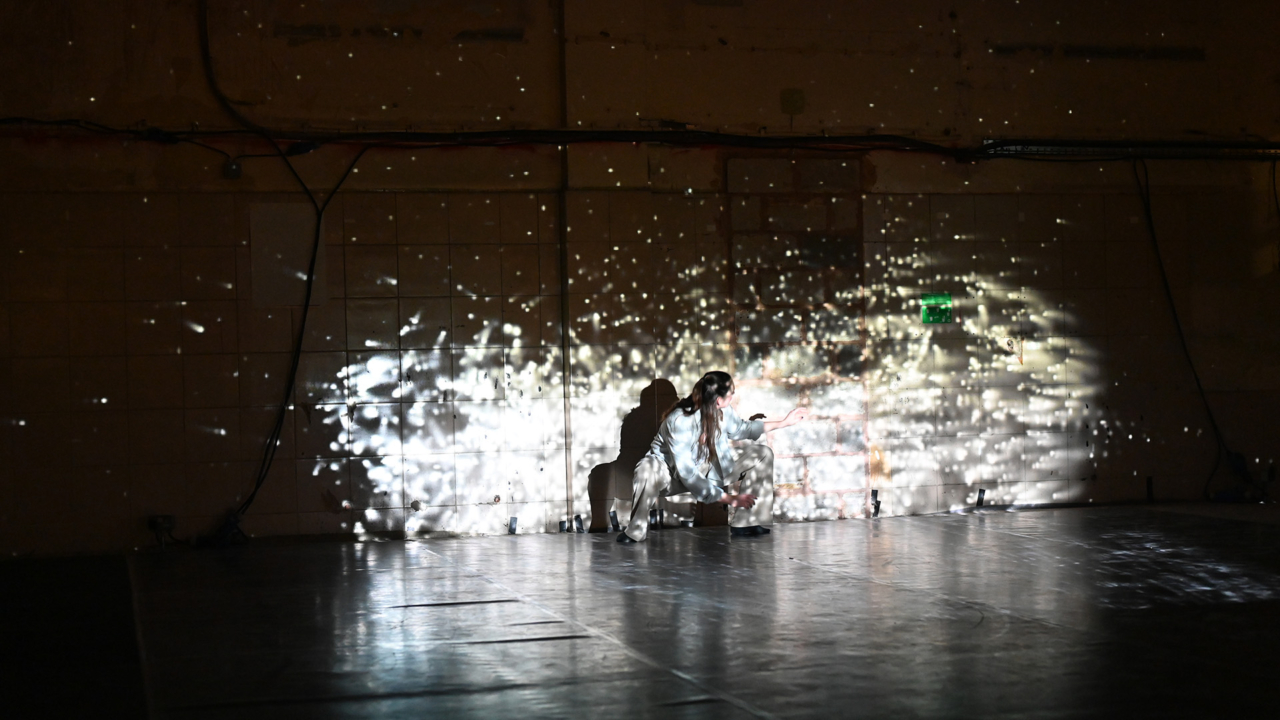
This case study was written by Dancefest – a dance school in Herefordshire and Worcestershire. They outline their journey in sustainably transforming an unused building into a vibrant, temporary dance and arts space, demonstrating how ethical procurement, community involvement, and resourceful design can bring life to a neglected urban location while preparing for future larger-scale projects.
The case study is one of over 50 practical examples of cultural organisations taking climate action including in depth case studies written for Arts Council England and Julie’s Bicycle’s Environmental annual report 2023-24. Check out the full interactive report here.
About Dancefest
Over three decades Dancefest has provided opportunities for over 200,000 people to take part in contemporary dance, through our programme of classes, workshops, school and community projects. We have created outdoor performances on our high streets, at stately homes and in public open spaces (both urban and rural) reaching audiences of over 150,000 people. We have created communities, nurtured young talent, ignited curious minds and restored spirits. We take people on creative journeys and play a key role in the cultural ecology of our region.
Dancefest doesn’t have its own space. We have an office in a shared community building and hire a range of arts and community spaces for our dance classes, projects and events. We wanted to trial having a space to call our own, to be aspirational in our programming, to make our brand stand out. We wanted to influence sustainability, ethical procurement and environmental responsibilities in a way we couldn’t in a shared space, where there can be a clash of priorities.
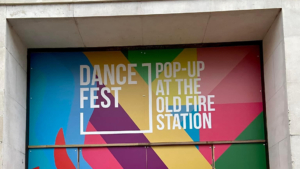
Breathing Creativity Into an Unused Space Sustainably
In October 2023, thanks to a successful application to Dance Hub Birmingham’s Investment Programme, which aimed to support a diverse range of projects in Birmingham and the West Midlands, as well as The Bransford Trust, and our regular funding as part of Arts Council England’s National Portfolio, we had funding to make a short term, pop-up dance and art space in the heart of Worcester city, with a mix of dance classes, performances and workshops for all ages.
We had three months to create a welcoming and contemporary space from a very bare shell; to programme and publicise our work; and contribute to the town centre being vibrant and creative for people living in Worcester as well as those visiting the city.
This was a step change for us, in having a space to call our own, to programme freely and at any time we wanted. All the restrictions of sharing and hiring were gone. This was a chance to do something we’d never done before – to try making, curating and programming our own space, to widen our reach, engage new and current audiences in inventive ways, to collaborate and create exciting new work. To bring to life an unused, unloved building for a short time, and to do so in a sustainably conscious way.
With the support of Worcester City Council in our search and having looked at several others along the way, we found our space. We took over the Old Fire Station in Copenhagen Street, Worcester. The space was a shell, it needed a lot of work and care to make it happen, but the team just fell in love with it as soon as we walked in. Here we met a friendly landlord who was intrigued by our proposal and vision – and consequently excited about the work whenever he visited or attended events. We had a limited time and a limited budget, but we immediately saw its potential. The space had been empty for some time, so we were making use of an unused space during a period where it was waiting for a purpose.
It was important for us to manage the development sensitively and sustainably, and we planned to borrow and buy pre-loved items to create our space. We put in temporary light and heat, installed basic toilets using ceramic, wood and other sustainable materials, rather than portable chemical toilets. We furnished it with preloved items from charity shops and loaned from the community. We borrowed beautiful olive trees from a local grower, we had plants and crockery donated by dancers, and were loaned chairs and tables by Heart of Worcestershire College, who also offered advice.
Anything we needed to buy for the space was carefully chosen to ensure that it would be a future asset for Dancefest. We bought an underlay for our dance floor that can be used for future outdoor performances, consulting with Motionhouse for advice.
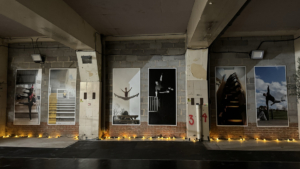
Community Involvement and Space Sharing
We wanted to tread lightly and involve our community of dancers and colleagues in helping us get it off the ground. We always wanted them to feel involved and engaged.
We talked to dancers and their families in classes, posted on social media, and included in e-flyers that we’d like to borrow furniture, plants, supplies, that we’d return at the end of the three months. We made it clear we wanted to dress the space sympathetically and sustainably, to let it breathe, borrowing items for a short time and then returning them. We hoped that this would make people feel part of the project and close to the work. There was an open invitation to pop in and visit, to see how things were progressing, and many took up this offer and loved the gentle way we were all making our space together.
The producer we engaged for the project, Ellie Turner, has many years’ experience working in outdoor arts and creating events that put artists, communities and the environment and landscape in which they are created at their heart, and made sustainability and ethical buying a key element of the Old Fire Station development.
We invited regional artists, dance companies and organisations to use the space for free or a small donation. We wanted it to be shared and well used. The offer was taken up by several local and regional artists and companies – ME Dance Company for youth sessions; a recent dance graduate who filmed her show reel; dance artist Sabira Mollah for rehearsals with people with learning disabilities; and Spectra and Everybody Dance for inclusive workshops.
We used it for parents and wobblers, children’s and youth dance classes, creative, choreography and exercise classes for adults, sessions with our Jigsaw Inclusive Dance classes for people with and without learning disabilities, rehearsals for a White Ribbon event involving dancers from our community classes at Worcester Community Trust Hubs, creating a dance in a day for Worcester’s Victorian Christmas Fayre, and a Disco Inferno afternoon rave for families and for adults, with DJ Ed Steelefox.
We also used the space for the start of AURA, a project created by Artistic Director Robby Graham of Southpaw Dance Company, with community and professional dancers. AURA was created and performed for Worcester’s Light Night. As part of research and development for AURA, we invited stakeholders to a reception and sharing of the work. This was significant in galvanising support for Dancefest, which has resulted in improved strategic partnerships and some onward funding. It also illustrated how an arts space can be created quickly, cheaply and ethically.
We enjoyed working with the University of Worcester’s Graphic Design department on a brief for the design on the temporary door. The lecturer of the course facilitated students presenting ideas to us as a sample client, and they were excited by this unusual commission which would be brought to life. Emily Harris creative’s design was chosen and made into a design for our large front door, incorporating our brand alongside her ideas. We hope it will be valuable for her portfolio.
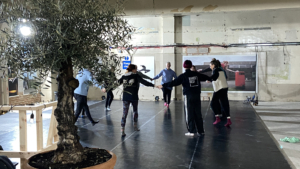
Outcomes and Reflections
This was a fantastic and incredibly exciting opportunity for Dancefest, building on our 30-year history in the region, allowing us to reach new audiences and interact with the city in new ways. It allowed us to experiment, test ideas, develop new partnerships and shape our future.
There was scope for trying new things, and people were inspired by the environment they were in. Being in this dedicated, carefully and mindfully created space made people feel more connected, creative, empowered. There was great kindness and support from our dancers and from colleagues. It felt like people were so pleased and excited for us, and it raised expectations and aspirations.
In our own space, we were conscious that our buying choices would be in line with our ethical and environmental agenda, from the coffee we offered, to the way we sourced our furniture.
Comments made by people visiting or taking part detailed everything people liked about the new space from its industrial look, the scale, the dance floor, the welcoming feel, the indoor trees but also its location, accessibility, and contemporary feel.
Looking back to write this, we as an organisation, achieved a huge amount in a short time. It solidified us as a team, all working together to manage it, as well as our other regular work. This was also a time of transition for Dancefest, just after our founder director had retired.
At The Old Fire Station, we had a chance to chat to people who took part in classes, in a way we haven’t before. The seating areas made people feel welcome, they popped in early or when they were passing. They wanted it to happen as much as we did.
We had a story to tell, which featured in local press. We had a sign and our very own door for the first time and people knew where we were, had seen or heard about this new pop-up. It allowed us to explore the space, to be on brand, and to see what impact having a building made. We could welcome everyone into our own space in a way that we couldn’t as much in a hired space.
We also discovered things we weren’t expecting. Responding to the space made it a much more creative and sustainable initiative than if we’d had imposing plans for change. It was such an organic way of working, responding to the space, being gentle, leaving nothing behind. The way we made and developed the space in a creative and sustainable way moves forward with us.
It was also a brilliant time for collaboration and community. So many people and organisations helped us make it happen, worked with us and supported us, and those connections move forward with us.
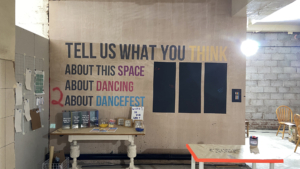
Leaving the Space and Next Steps
We loved the rough walls of the Old Fire Station, the bricks and concrete floor and we wanted to let the space breathe, rather than impose. We always wanted to gently move in and then move on. We added toilets and cleaned the walls and floor but otherwise, we placed images we already had from a previous dance and photography exhibition along walls, and furnished it with borrowed, pre-loved items and loaned plants and olive trees. Our vision was always to tread lightly and sustainably. We returned all items, and left the space unharmed but enhanced, and with an aspiration for it and us for the future.
This project has brilliantly prepared us for our part in a Creative Consortium as work begins on the Scala in Worcester. It gave us insight into the implications of running our own space, enabling us to better feed into planning for the Scala, including sustainability initiatives. We were resourceful, inspired and made it the most exciting space we could.
The Creative Consortium is a group of some of Worcester’s leading arts, cultural and creative organisations: Dancefest, Severn Arts, C&T, The Kiln, Mobilise and Vestan. This exciting project will see Worcester’s Scala and Corn Exchange (now on the Heritage at Risk Register) brought back to vibrant life. They will be sensitively restored, and our visits to them have chimed with our first visit to the Old Fire Station.
The work we did around sustainability and ethical purchasing at The Old Fire Station is embedded in our plans and will continue to influence our work with the Scala, as well as all future projects.
Header image: OFS AURA R and D sharing – Dancefest – Credits: Jane Hall
